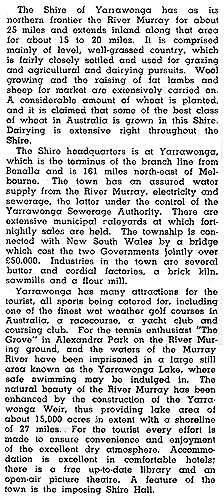Yarrawonga is a town on the Murray River, 215 km. north-north-east of Melbourne. It is linked to Mulwala, on the opposite side of the river in New South Wales, by road and railway, and the Mulwala munitions factory is a source of employment for residents of Yarrawonga. Lake Mulwala (1939) on the Murray River has recreational frontages to Mulwala and Yarrawonga.
Yarrawonga was named after a pastoral station taken up by Elizabeth Hume (sister-in-law of the explorer, Hamilton Hume), in1842. The name is thought to be derived from an Aboriginal word meaning place where the wonga pigeon rested, or water running over rock. Elizabeth Hume’s homestead, Byramine, was built in 1842 and is on the Australian and Victorian historic buildings registers. It is in the locality of Burramine,which is about 14 km. west of Yarrawonga.
A police camp was established at Yarrawonga in about 1850.
In 1868 a town was surveyed at Yarrawonga, occupying the four blocks bounded by Witt, Hume, Orr, and Hovell Streets near the river. Town blocks further south were surveyed in 1875 and 1886. The railway from Melbourne reached Yarrawonga in 1886. A bridge across the river to Mulwala was built in 1891.
With the opening of the railway wheat and livestock were easily transported to Melbourne markets and the township rapidly grew from a few hundred persons to over one thousand.
In 1878 the Yarrawonga shire was created, extending from Cobramin the west to the Ovens River in the east and southwards to the boundary of Benalla shire. The shire’s area of 813 sq. miles was trimmed down to 220 sq. miles by 1891, which remained its area until amalgamation in 1994.
Even before the coming of the railway in 1886, Yarrawonga township had two banks, four hotels, three churches, several stores, a school (1876),a newspaper and two flour mills. The district boasted that it grew some of the best wheat in Australia. In 1891 a second newspaper was published, hotels numbered six and town water was reticulated. Yarrawonga was described in The Australian Handbook, 1903 –

In 1925 an unusual community organisation was formed in Yarrawonga. Anon-profit cinema company was formed to raise funds for community projects.Its first project was the riverside Alexandra Park. During the next forty years about $120,000 was raised. In 1938 the Yarrawonga weir was built, forming Lake Mulwala. The lake became the town’s prime tourism asset, as well as leading to a foreshore improvement committee (1944) and swimming and yacht clubs. The shire was described in The Australian Blue Book, 1949-

In 1957 the first of Yarrawonga’s aquatic festivals was held. Lakeside camping and activities increased, quadrupling the local population during holiday times. Lake Mulwala has an area of 6,000 hectares and 43 kilometres of shoreline. There are seven boat ramps and two swimming pools. Alexandra Park has an oval, tennis courts and 500 caravan sites. There are bowling greens, a golf course bordered by State forest and facilities for fishing and shooting. The area attracts retirees: in 1996 nearly 19% of the population were over 65 years compared with a regional average of 14.1%.
The town has State and Catholic primary and secondary schools, a hospital, several local industries, an aerodrome and a livestock sale yard. Within the shire as a whole there were 777 bed spaces in camping areas and 410 bed spaces in hotels and motels (1995). Yarrawonga annually has more hours of sunshine than Brisbane.
In 1994 the shire had 23,000 head of cattle, 78,000 sheep and lambs and harvested over 16,000 tonnes of wheat. Farms occupied over 51,000 hectares or 81% of the shire’s area.
The median house price in Yarrawonga n 1987 was $71,100 and in 1996 it was $97,000.
On 18 November, 1994, most of Yarrawonga shire was united with Cobram, Nathalia, Numurkah and most of Tungamah shires to form Moira shire.
Yarrawonga’s census populations have been 366 (1881), 1,278 (1891), 1,908 (1933), 2,953 (1954), 3,603 (1991) and 3,435(1996). The shire’s census populations were 3,109 (1911), 3,724 (1961) and5,521 (1991).
Further Reading:
- Dunlop, Alan J., Wide Horizons: The story of Yarrawonga, Tungamahand Cobram Shires, the author, 1978.
- Loughnan, A. Noel (ed.), From Ballanda to 1968: The Story of Yarrawonga, Yarrawonga Apex Club, 1968.




didnt find what i wanted =(
sounds like a great place to visit..